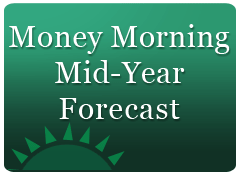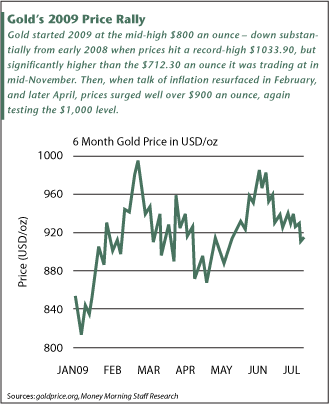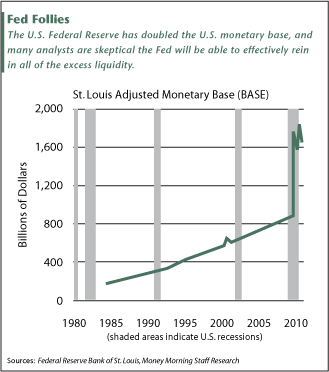With Inflation on the Horizon, Gold Prices are Ready to Rocket
Commodities / Gold & Silver 2009 Jul 16, 2009 - 11:49 AM GMTBy: Money_Morning
 Jason Simpkins writes: With the global economy on the mend, could gold be gearing up for another record-setting run? It sure looks that way. After peaking north of the $1,000 per ounce price level last year, gold hit a stumbling block when deflationary fears in the world's largest economy sucked the air out of commodities prices and sent hoards of investors stampeding into the safe-haven of U.S. Treasuries, and helped spawn a rebound in the U.S. dollar. Since that time, the global economic outlook - especially beyond U.S. borders - has improved, and gold prices have stabilized. The next step - many gold bulls say - is for the yellow metal to make a run for new highs.
Jason Simpkins writes: With the global economy on the mend, could gold be gearing up for another record-setting run? It sure looks that way. After peaking north of the $1,000 per ounce price level last year, gold hit a stumbling block when deflationary fears in the world's largest economy sucked the air out of commodities prices and sent hoards of investors stampeding into the safe-haven of U.S. Treasuries, and helped spawn a rebound in the U.S. dollar. Since that time, the global economic outlook - especially beyond U.S. borders - has improved, and gold prices have stabilized. The next step - many gold bulls say - is for the yellow metal to make a run for new highs.
 Whipsaw Trading Patterns
Whipsaw Trading Patterns
Gold started 2009 at about $870 an ounce - down substantially from early 2008 when prices hit a record-high $1033.90, but significantly higher than the $712.30 an ounce it was trading at in mid-November. Then, when talk of inflation resurfaced in February, and later in April, prices surged well over $900 an ounce, again testing the $1,000 level. Gold prices hit $983 in early June - a 38% jump from their November low.
Gold prices have since lost some of that momentum, dropping back down to $940 an ounce, but many analysts believe this is where gold will find support before eventually shooting back to $1,000 - and possibly even higher - by the end of the year. There are many reasons to believe that gold is poised for such a strong showing: Supply of newly mined gold is dwindling, fresh discoveries of deposits are on the wane, and demand has remained strong. But the biggest reason analysts believe gold will rebound to its 2008 apex is that the medium and long-term outlook for dollar is rapidly darkening.
 Government Support for Gold
Government Support for Gold
With the U.S. Federal Reserve pursuing a policy of quantitative easing and a federal budget deficit that's spiraling out of control, the dollar is extremely vulnerable. The Federal Reserve has lowered its benchmark Federal Funds rate to a range 0%-0.25% and has said it will remain there for "an extended period." The Fed has also injected more than $2 trillion into the financial system, expanding credit through increased loans to banks to provide liquidity. It's also created the Commercial Paper Funding Facility - which holds $109.2 billion in short-term IOUs issued by corporations - and the Term Asset-Backed Securities Loan Facility (TALF) - which has lent $25 billion to investors to buy securities tied to auto and other consumer and business loans. And the central bank itself has pledged to buy $1.75 trillion in mortgage-backed securities, Treasury notes, and federal housing agency bonds. "In the last year alone, the U.S. Federal Reserve has actually doubled the U.S. monetary base," said Money Morning Contributing Editor Peter Krauth. "That can only lead to serious inflation, perhapseven hyperinflation.
This will cause the value of the U.S. dollar - which has been eroding since 2001 - to decline at an even-more-frenetic pace." In addition to the Fed's action, the United States' spiraling debt poses a significant threat to the dollar's value, as well. Federal debt will reach $12 trillion by this fall and exceed $13 trillion by September 2010, according to the Congressional Budget Office (CBO). The CBO projects the U.S. budget shortfall will reach at least $1.85 trillion - equivalent to 13% of the nation's gross domestic product (GDP), a level not seen since World War II - in fiscal 2009. And if the economy doesn't rebound soon, that number will very likely top $2 trillion by the end of September. The CBO anticipates the deficit will shrink to about $1.4 trillion in fiscal 2010 and $1 trillion in fiscal 2011, if the economy continues to stagnate, there is a good chance that those budget shortfalls will be even greater than the fiscal 2009 deficit.
 Some of U.S. President Barack Obama's advisors have already acknowledged that the administration underestimated the rapid rise in unemployment and that a second stimulus may be in the cards. Laura Tyson, former chair of the U.S. President's Council of Economic Advisers during the Clinton administration and current advisor to President Obama, said July 6 that the $787 billion stimulus passed in February was "a bit too small," and that more may be required. But if another stimulus is needed, how exactly does Washington plan on financing it? While the government has continued to find buyers for its Treasuries, the question being asked by analysts is at what point will investors start to balk at continuing to finance the American expenditures. China - the largest holder of U.S. debt - is already losing its appetite for U.S. Treasuries. In fact, the world's fastest growing economy has already admitted to stocking up on gold to hedge against the dwindling value of its dollar holdings.
Some of U.S. President Barack Obama's advisors have already acknowledged that the administration underestimated the rapid rise in unemployment and that a second stimulus may be in the cards. Laura Tyson, former chair of the U.S. President's Council of Economic Advisers during the Clinton administration and current advisor to President Obama, said July 6 that the $787 billion stimulus passed in February was "a bit too small," and that more may be required. But if another stimulus is needed, how exactly does Washington plan on financing it? While the government has continued to find buyers for its Treasuries, the question being asked by analysts is at what point will investors start to balk at continuing to finance the American expenditures. China - the largest holder of U.S. debt - is already losing its appetite for U.S. Treasuries. In fact, the world's fastest growing economy has already admitted to stocking up on gold to hedge against the dwindling value of its dollar holdings.
With the Dollar Diving, China Turns to Gold
China bought less than a sixth of the Treasuries issued by the U.S. government in the 12 months through March. That stands in stark contrast to the Treasury market of two years ago, when China's demand for U.S. securities actually exceeded the United States' own borrowing needs. Additionally, when China has purchased Treasuries, it has done so by swapping them with other U.S. assets, rather than exchanging foreign currencies or commodities.
China has increased purchases of short-term Treasury notes - those that mature in a year or less - while at the same time unwinding its position in Treasuries with longer maturities. "They are worried about forever-rising deficits, which may devalue Treasuries by pushing interest rates higher," JPMorgan & Co. (NYSE: JPM) analyst Frank Gong told The Associated Press. "Inside China, there has been a lot of debate about whether they should continue to buy Treasuries." As Money Morning reported in June, Treasury Secretary Timothy F. Geithner traveled to China to reassure the nation about the value of its holdings. But not everyone was convinced. "I worry about details," said Yu Yongding, a former central bank adviser who interviewed Geithner for the China Daily newspaper. "We will be watching you very carefully."
Prior to Geithner's visit, Yu told Bloomberg News that he was hopeful for details on the U.S. plan to support the dollar. He also warned that despite its sizeable commitment to U.S. debt, China has other options. "I wish to tell the U.S. government: 'Don't be complacent and think there isn't any alternative for China to buy your bills and bonds,'" said Yu. "The euro is an alternative. And there are lots of raw materials we can still buy." One such raw material is gold. China recently announced recently that it has increased its holdings of gold by about 450 metric tons in the past six years. "Gold is shifting back from a sovereign reserve asset central banks were inclined to underplay to one of growing, strategic interest," said Trevor Keeley, global head of sovereign client services at the Anglo-Swiss bank UBS AG (NYSE: UBS). "This shift is logical; gold remains the world's primary financial asset that is no one's liability."
And China's not the only one loading up on the yellow metal. Whether it's through exchange traded funds (ETFs), or acquiring actual gold bullion, investor demand for gold continues to soar. Individuals' bullion purchases almost doubled last year to 862 metric tons, The Wall Street Journal reported. And while gold buying by investors has fallen from its 2008 peak, the volume still remains historically high. The 130 metric tons of gold purchased in the first quarter of 2009 is 50% higher than this decade's average quarterly volume. Of course, bullion isn't the most practical way to get in on gold's pending surge.
How to Stock Up on Gold
One way to stock up is to buy gold outright, either in bars, or though the gold-linked, exchange-traded fund (ETF) SPDR Gold Shares (NYSE: GLD). Today, SPDR itself holds more than 1,000 ounces of gold, and has a market capitalization of $33 billion. The fund's price fluctuates in concert with the price of gold, which adds a small mount of risk. On the other hand, however, buying this ETF is more convenient than buying gold bars directly, because the fund dispenses with the accompanying storage problems that comes with actually owning physical gold.
Buying stakes in gold miners is an excellent way to hedge against the enormous inflationary pressures filtering through the U.S. economy. In this case, the Market Vectors Gold Miners ETF (NYSE: GDX) - composed chiefly of major gold miners - offers both company and geographic diversification, while including substantial leverage to the price of gold. Market Vectors is based on the AMEX Gold BUGS Index (HUI), which represents a portfolio of 15 major gold mining companies that do not hedge their gold production beyond a year and a half.
[Editor's Note: If you're new to the commodities-investing arena, and are uncertain about the landscape - or even if you're an "old hand" at natural-resource stocks, but want some insights into the new profit plays and new players - consider hiring a guide: Money Morning Contributing Editor Peter Krauth, a recognized expert in metals, mining and energy stocks, is also the editor of the Global Resource Alert trading service, which ferrets out companies poised to profit from the so-called "Secular Bull Market" in commodities.
A former portfolio advisor, Krauth continues to work out of resource-rich Canada, which keeps him close to most of the companies he researches. Against the growing global financial malaise, Krauth says that commodities are among the most-profitable and least-risky investments available, and notes that this may well be the most powerful bull market for commodities we'll see in our lifetimes. He makes a strong case. To read more about his strategies, and the sector plays he likes the most, Please click here. ]
Money Morning/The Money Map Report
©2009 Monument Street Publishing. All Rights Reserved. Protected by copyright laws of the United States and international treaties. Any reproduction, copying, or redistribution (electronic or otherwise, including on the world wide web), of content from this website, in whole or in part, is strictly prohibited without the express written permission of Monument Street Publishing. 105 West Monument Street, Baltimore MD 21201, Email: customerservice@moneymorning.com
Disclaimer: Nothing published by Money Morning should be considered personalized investment advice. Although our employees may answer your general customer service questions, they are not licensed under securities laws to address your particular investment situation. No communication by our employees to you should be deemed as personalized investment advice. We expressly forbid our writers from having a financial interest in any security recommended to our readers. All of our employees and agents must wait 24 hours after on-line publication, or 72 hours after the mailing of printed-only publication prior to following an initial recommendation. Any investments recommended by Money Morning should be made only after consulting with your investment advisor and only after reviewing the prospectus or financial statements of the company.
Money Morning Archive |
© 2005-2022 http://www.MarketOracle.co.uk - The Market Oracle is a FREE Daily Financial Markets Analysis & Forecasting online publication.



